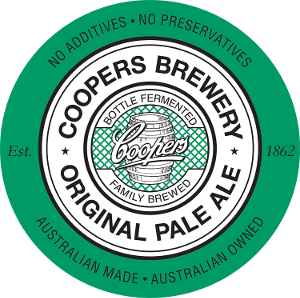ABV: 4.5%
Origin: Regency Park, City of Port Adelaide Enfield, South Australia
Website: http://coopers.com.au
Date: 18 September 2000
Another review from the archive written for the pioneering Oxford Bottled Beer Database (OBBD). I’ve left it uncorrected — so please read it in that historical spirit. A beer from a classic historic brewery which is thankfully still around 16 years on. Unlike the Pitfield Beer Shop, where I bought my review bottle.
Coopers of Adelaide were the last bastion of craft brewing in Australia for many years, doggedly sticking with their range of idiosyncratic bottle-conditioned ales while the rest of this vast country succumbed to corporate lager. Like a number of other world-class speciality breweries, they have a very distinctive house character that includes some characteristics which, on their own, might be seen as unpleasant and undesirable but, when properly balanced, add immensely to the interest and enjoyment of the product.
The beers have an extremely lively bottle fermentation which gives them an assertive carbonation but, underneath this, they are actually quite thin textured, and they have a salty, brackish quality, like the whiff of an estuary wall at low tide — a quality also apparent at Adnams in Southwold and among certain single malt whiskies.
In the brewery’s flagship Sparkling Ale and well-loved Stout, these qualities co-exist with other strong, rich flavours, but in the present lesser-known and more delicately flavoured product, picked up at the Pitfield Beer Shop, they are much more prominent.
Poured clear, the pale ale is actually an extremely pale yellow colour; swirled round the bottle and poured with the plentiful sediment, as is traditional, it takes on a more peachy hue. It has a marvellously thick, rocky and long-lasting head and an intriguingly strong nose, with yeast, banana (another house characteristic) and a definite tang of seaweed.
In the mouth, it’s noticeably less complex and more delicate than Sparkling Ale, predominantly toffeeish malt behind the very lively carbonation, and as the beer settles, the salty vegetal taste comes through more clearly. A developing hop character is distinctly bitter but also refreshingly rounded, and the hops continuing into the finish along with slight mineral hints.
As a Coopers fan I thought this made a nice change, though it’s clearly not in the world classic class to which its stablemates aspire, and, for the uninitiated, probably not the best introduction to the brewery’s delights.






Leave a Reply